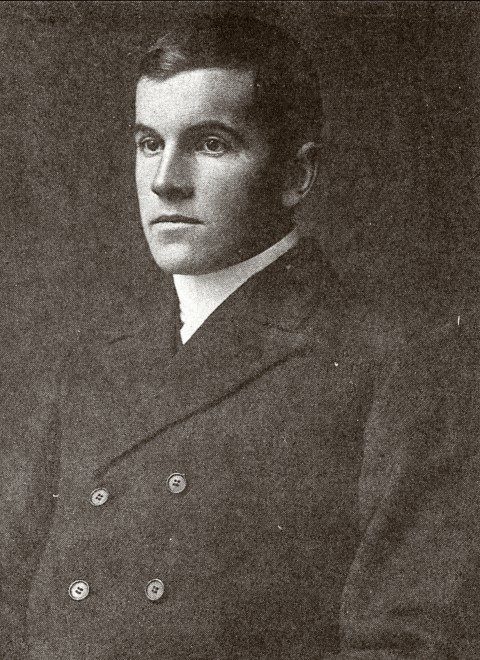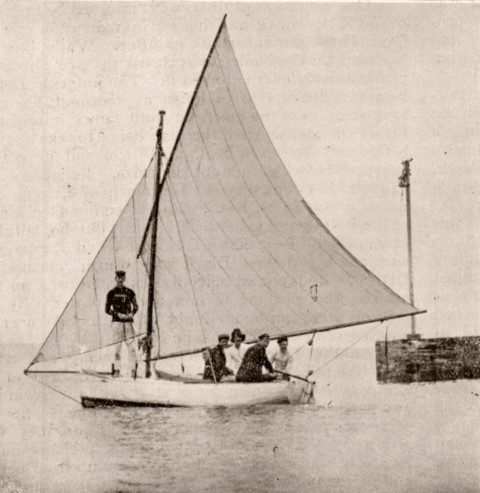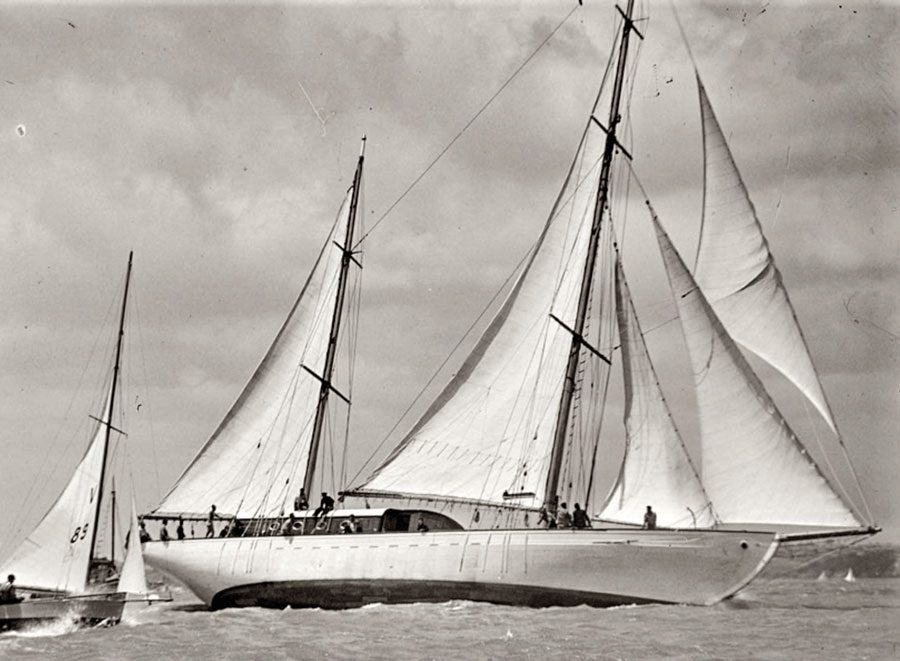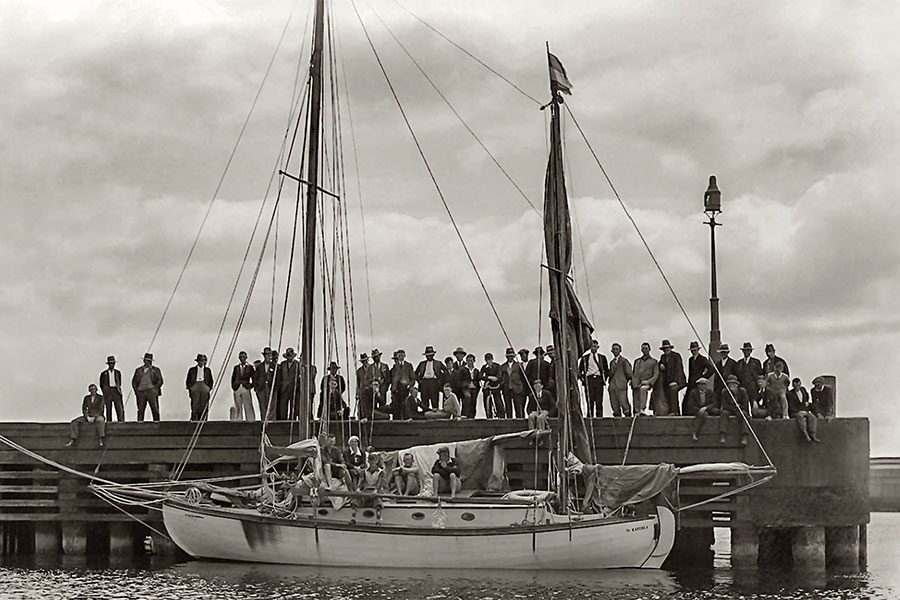

The Freyberg brothers had an overdose of daring in their DNA. They were all six-footers and strode through their lives, seemingly oblivious to danger. Story by Harold Kidd.
While the youngest brother, Bernard Cyril Freyberg, known as ‘Tiny’, came to overshadow his elders during the two wars, the brothers all contributed greatly to the sports of yachting and swimming in Wellington around the turn of the 20th century.
Their father, James Freyberg, was the son of a Saxon who settled in England after the Napoleonic Wars and married an English lady. The Freybergs had been German mercenaries in Russia for some generations.
James was a qualified surveyor and valuer and something of an entrepreneur and inventor. He and his Scottish wife Julia brought their family of five young boys to Wellington on the Aorangi, arriving on December 1st 1891.
The five sons had all been born in Richmond, London, Oscar in 1881, Paul in 1884, Cuthbert in 1886, Claude in 1887 and Bernard in 1889. The family lived in Hawker St, a short distance from Oriental Bay and, from 1905, the Clyde Quay Boat Harbour.

Their father James was a martinet, so the boys had little affection for him. In 1894 James became the New Zealand Government’s accredited Timber Expert, at home, struggling to persuade landowners and sawmillers to cease the wholesale rape of our native forests for export, and back in London, trying to push our local high-grade timbers for use in cabinet-making.
Julia, their mother, provided their early schooling until they were old enough to go to Wellington College. They had risk-taking in their genes, roaming the scrub-covered hills of what is now Hataitai, and excelling at water sports.
As a youth of 15, Oscar started yachting with a nine-foot sailing dinghy called Taipo followed by the newish 14-footer Kura he bought from Penty and Beck in January 1896. Kura was part of a growing fleet of centreboard 14-footers developing in Wellington, sponsored by the Port Nicholson Yacht Club and the Arawa Sailing Club.

Oscar hit the headlines when he and two other lads took Kura on the afternoon of Saturday 12th December 1896 outside Cape Palliser to investigate the wreck of the barquentine Delmira which had gone ashore the previous Tuesday. In 1910 Oscar wrote the full, harrowing story in New Zealand Yachtsman magazine, but a brief newspaper account follows:
“Three youths, named Oscar Freyberg, aged 16, Victor Welsh 17, and Morton Smith 18, who were anxious to see the wreck, left port at midnight on Saturday, in a 14-foot boat, and had a rather eventful experience. They reached Cape Palliser at noon on Sunday, when they met with a gale and attempted to return, but could not get back, and were eventually blown off the land.
“Fortunately, the steamer Hesketh, which was coming to Wellington, sighted the frail craft and took the occupants on board. They were then ten miles off the land, and were in an exhausted condition, not having had anything to eat or drink since Sunday forenoon. They said that in another hour or two they must have succumbed.”

Oscar was not dismayed by this close shave. His next adventure was sailing the eight-ton keel yacht Neva up from Lyttelton with a crew of young lads, cruising the Sounds in her and delivering her to Wellington during the Christmas holidays of 1897.
Neva had been built in Lyttelton in December 1885 by Tom Westlake for John Galbraith, the son of Capt. John Galbraith of Lyttelton. She was one of the new boats built in the upsurge of interest in yacht building in Lyttelton that produced Pastime, Little Wonder and Mascotte to counter the old Bailey cutter
Fleetwing and the Dunedin-built flyers Zephyr and Mahanga, the former Clementina. (see VintageView May 2019).
Neva proved handy in Second Class races with the newlyformed Canterbury Yacht Club but by 1892 was becoming outclassed. Her third owner, T. Martin, donated her to the Christchurch Sailing Club at Monck’s Bay in the Estuary, for members’ use. The Club kept her at Lyttelton where Westlake maintained her.

The expense became unsupportable, so she was sold, probably for very little. It may have been only a delivery voyage for Oscar. If he did own her, he did not keep her for long because she sank at her moorings off the Wellington Rowing Club in August 1898 when owned by a Mr. Arrowsmith, was salvaged by Harry Bender and disappears, probably recycled by Bender. I have been unable to find an image of Neva, unfortunately.
Oscar next bought the 14-footer Moana, racing her very successfully with the Arawa Sailing Club during the 1898 season. At the end of 1898 he moved up to the 28ft keel yacht Ariel which was one of two yachts of that name in Wellington at the time, the more prominent one being the Robert Logan- built 5-tonner Jessie Logan-derivative which Arch Buchanan of Auckland sold to Wilson, Haggett and McLeod of Wellington in late 1897. Unfortunately she broke away from her moorings in Te Aro in a southerly gale and was smashed to pieces at Petone in June 1898.

Oscar’s Ariel had been built as Dream by Lintoff for E. Pollard in 1885. Pollard owned her until August 1891 when Tom Wardrop bought her and sold her in 1892 to Campbell who rechristened her Ariel.
She went through a couple more hands until Penty, Beck, Moore and Silk sold her to Oscar in November 1898. They had bought her just for her lead for the keel of the smart new Mantell Silk-designed 2½ rater Mawhiti they had built and were about to launch.
Lead was a valuable commodity in the Victorian period. Lead as ballast was a large proportion of the cost of construction of a yacht and the weight of its lead keel or internal ballast was the bottom-line value of a second hand yacht.
Oscar Freyberg’s purchase of Ariel was a common example of lead- swapping for shoe-string yachting. Seventeen-year-old Oscar had bought just the hull of Ariel on Richard Huffam’s slip at Te Aro and had to scout around for lead. Some came from the wreck of the Logan Ariel, smashed up a few months earlier, some came from the yachts Dido and Haeata.

Dido was another early Port Nick keel yacht, amateur-built by the Kirk brothers at Courtenay Place in 1884, which achieved notoriety when she was stolen and sailed to Lyttelton in January 1888. She was a straight-stemmed cutter of only 22ft with a 7ft beam carrying a ton and half of ballast on her keel. Dido was remarkable for her bowsprit, which extended a full 14ft from her stemhead. Dido went on the rocks at Point Jerningham and was broken up by Huffam. Oscar bought her lead.
Haeata started life as the one-rater 21ft keel yacht Vulcan built by C. McKeegan in December 1886 for Herbert Smith. Vulcan was successful in 3rd Class racing with the Port Nicholson Yacht Club and in the Wellington Annual Regattas over the years.
In 1898 her owner was R.C. Renner, one of the 14-footer crowd, who had owned the centreboarder Muritai and went on to own many fine yachts including the Bailey 2½ rater Rogue, which he renamed Muritai, Rona and a share in Waitangi. Oscar Freyberg bought Haeata for the 15cwt of lead on her keel and sold her hull.
Ariel was ready to sail by Christmas 1898. She had a good cruise in the Sounds over Christmas, but her life was but brief. Some friends of Oscar’s ‘borrowed’ her in March 1899 and put her ashore in Oriental Bay where she was smashed to pieces. Not at all deterred, in the winter of 1899 Oscar bought the yacht Mapu.
I shall relate his and his brothers’ later incredible escapades in a future article.
TELL YOUR STORY
Do you have a vintage story you would like to share with our readers? Contact Harold at: haroldkidd@boatingnz.co.nz




